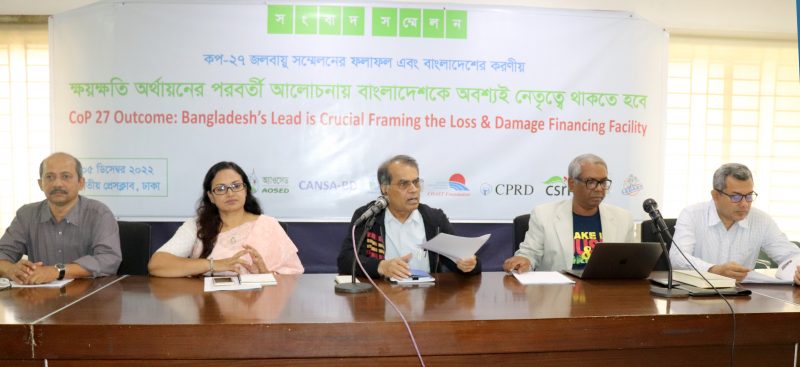Bangladesh Should Lead the process of Developing a Framework for Loss & Damage Finance Facility

Press conference held in Dhaka, 5 December 2022
A group of Bangladeshi CSOs, led by COAST Foundation organized a media sharing event on the outcomes of recently held 27 th Conference of the Parties (COP 27) of the UNFCCC. The group comprising representatives of CANSA and CANSA Bangladesh, Center for Participatory Research and Development (CPRD), Campaign for Sustainable Rural Livelihoods (CSRL), AOSED and LEDARS raised their concerns on the poor outcomes, especially on raising mitigation ambitions under the NDCs, annually mobilizing 100 billion financial commitments from 2020 to 2025, leveraging private sector investment and capital market in financing adaptation and migration actions, and so on.
The group also slammed the cleverly articulated decision on the ‘new funding arrangements’ for responding as well as addressing losses and damages associated with the impacts of climate change. The group called upon the LDCs, MVCs, and Bangladesh in particular, to be actively involved in the discussion of the Transitional Committee that has been established at COP 27 to progress technical discussion until COP 28 next year and make the ‘new funding arrangements’ operational henceforth.
M. Rezaul Karim Chowdhury and Syed Aminul Haque of COAST Foundation moderated the press event and presented the key outcomes of COP 27 respectively. While the establishment of L&D Funding has been applauded as a great victory in the 30-years history of climate negotiation, yet there are many issues to be decided in a year run-up to COP 28 scheduled in November 2023. Chowdhury criticized developed countries and the COP presidency to deliver a complicated and tricky text on LDFF (Loss and Damage Finance Facility) and not recognizing persistent efforts and struggle of LDCs and SIDCs in the decision text. Aminul Haque put some demands for consideration, which include (i) Engaged leadership of LDCs, MVC and Bangladesh in particular, in the work of the Transitional Committee, to ensure L&D finances address the residual losses and damages associated with both sudden and slow processes of climate change impacts; (ii) Uphold Convention’s overarching spirit and principles, e.g., historical responsibility of global warming and CBDRR&RC while mobilizing L&D finances; (iii) Persistent pressure on enhanced emission reduction targets (under their Nationally Determined Contributions or NDCs) coherent to achieving 1.5 degrees Celsius temperature rise goal by 2100 from the pre-industrial levels; and (iv) Effective representation of the LDCs in the ad-hoc committee on NCQG (New Collective & Quantified Goal) process to ensure pro-poor interest in the upcoming financing arrangements.
In follow-up discussion, Ziaul Hoque Mukta of the Campaign for Sustainable Rural Livelihoods (CSRL) emphasized the importance of achieving 1.5 degree goal for the spaces of adaptation actions and minimize L&Ds burden on the climate vulnerable countries. He criticized COP 27 outcomes and the big polluters for supporting use of fossil fuel in the context of ‘clean energy use’ instead of their complete phase-out.
Ms Rabeya Begum of SDS and CANSA-Bangladesh Steering Committee Chair also called upon for enhanced emissions reduction especially by the Annex-1 countries under their NDCs. She raised the worrying concern on the steady rise of global warming already 1.1 degree Celsius and projected to reach 2.4 degrees by 2100, under full implementation of current emission reduction targets communicated by the NDCs. Such a temperature rise scenario will widen the adaptation gap, finance gap, also limit our scope and spaces for adaptation while making L&Ds irrecoverable and irreversible. She called upon the global political leadership and CSOs to provide utmost emphasis on emission reduction coherent to 1.5 degree Celsius temperature rise goal. On finance, Ms Rabeya slammed the developed countries for not fulfilling their commitment of mobilizing USD 100b annually from 2020, which they made a long time ago. Though the developed countries have fulfilled their commitment partially, for instance provided around USD 83 billion through different sources but more than 70 percent of them are loan and double counted both as ODA and climate finance. She demanded grant-based finances for adaptation actions and transparency in support.
Shamsuddoha of CPRD considered the decision text ‘L&D financing arrangements’ very strategic and cleverly developed and a different articulation than that of the Paris Agreement. The specific wording of the Paris Agreement, e.g., ‘addressing L7Ds has been segregated into ‘responding’ and ‘addressing’ wherein addressing will be followed by responding. Literally, responding to L&Ds is linked to averting and minimizing the risks of L&Ds. In terms of averting L&Ds, the decision text emphasizes keeping global average temperature rise to below 1.5 degrees C, meaning that the countries need to increase their emission reduction targets to comply the 1.5 degrees C goal. The text requires a comprehensive understanding on its different elements and dimensions.
On legal issues of L&D finances, he criticized inclusion of a footnote in the decision text that reads; ‘these items and outcomes thereof are without prejudice to the consideration of similar issues in the future’. This means that statements and decisions towards funding arrangements of L&Ds should be out of legal jurisdiction if Parties are failed to comply with the decision made here. This might allow the Parties to stay non-committed in mobilizing/providing finances for addressing L&Ds, if they wish so. Yet, he expects that the ‘Transitional Committee’ on the ‘new funding arrangements’ for addressing L&D will look into the above issues and make the Fund fully operational by 2023 while upholding the spirit of climate justice.
In the concluding remarks, Mr Rezaul Karim Chowdhury emphasized a new negotiation stream of LDC, MVC, and Climate Vulnerable Forum in the next COPs [Conference of the Parties] to strengthen the unified voice, especially on the new financing arrangements for addressing L&Ds.




